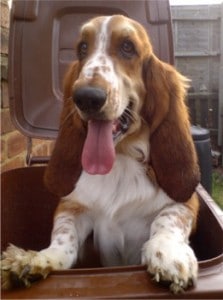From the desk of Sharda Baker.
Hi and Welcome Everyone!
This is Sharda with another Basset Hound training newsletter!
Today let’s talk about your Basset Hound family dog and meeting the rest of his new family!
Introducing a new family member to the family is never an easy task. Some may deal with it with enthusiasm, some may not.
So how do we introduce your Basset puppy or Basset dog to the whole family?
We will soon find out…
YOUR DOGS AND CATS MEETS YOUR NEW BASSET PUPPY
How would you get your Basset Hound to say hello to your cat? Tricky as it may seem, it still needs the same set of rules.
- You need one person to control the dog while you praise both animals.
- Your dog should be on a leash.
- Keep the leash on until both are calm. Otherwise if the cat runs, your Basset Hound may chase him.
- If they are friendly towards each other, reward them. If they stare, or if their fur stands on end, keep them apart.
- Your cat may be a little more stressed out. He may hide or stay away for some time. If so, ensure those places are inaccessible to your dog. Make sure that both do not attack each other’s food or crates.
YOUR KIDS AND YOUR BASSET HOUND
If you have little children and a Basset puppy, you need to supervise the time they spend together.
What else can you do? Be with them, teach your kids not to shout, scream, abuse or be cruel to your pet.
Neither should your kids ride piggyback on your little Basset Hound because it is bad for his bones. But your pet, being small, may not be able to cry, so he will either bay or growl. This means he’s scared, not aggressive.
PEOPLE AND YOUR BASSET HOUND
Allow your pet to get familiar with his new home and settle down. Once he is comfortable, you can introduce him to your family and friends.
Keep him on a leash and introduce him to one person at a time. Make sure the dog is calm. Reward him with a treat, if he behaves well.
You also need to reassure the visitor. If the Basset dog starts sniffing the guest, and most dogs do, your guest could become tense.
The Basset Hound could interpret this as a challenge. Observe your dog. Is he comfortable? Is he relaxed? If not, it may be wise to delay introductions for a while.
Your Basset Hound may growl, jump at people or bay. Most people allow their pets to jump on people; this is a mistake. So teach him the, “off” command from day one.
This is one behaviour that is tough to correct as he becomes older. As your pet becomes more and more familiar, as his socialization skills improve, you will notice how much he can have.
Besides, your family and friends too will start relaxing when he is around. All of which makes it worth having a basset.
HOW TO MAKE YOUR NEW PET FEEL SECURE IN HIS NEW HOME
Your resident pet may have begun to feel insecure about his position. So please, comfort him and pet him but do not allow any aggressive tendencies to be shown towards the new pet.
This is where socialization and Basset Hound training at an early stage plays an important part. If both dogs have been socialized, it will take them very little time to get friendly. Remember not to look or act nervous.
This could be communicated to your pets.
Your new pet’s crate should not be close to the others. This might unnecessarily irritate your older pet. If you cannot supervise, make sure they are separated.
Your pets will soon get used to each other slowly. However, you must spend some time with them every day.
Play with them, feed and train them. Spray them with water or whistle if they misbehave. Reward him for good behaviour.
You must continue to socialize your pets and Basset Hound training.
Introduce them to new experiences, new people but always be the leader. Your pet can smell fear and make out when you are not in control, so take care.
Your Basset Hound should begin learning social skills as soon as possible. This is very critical. Make sure you don’t expose him to any situation where he feels threatened.
That’s it for today!
I hope you learned something important today.
All the best and take care
Warmly,
Sharda Baker

